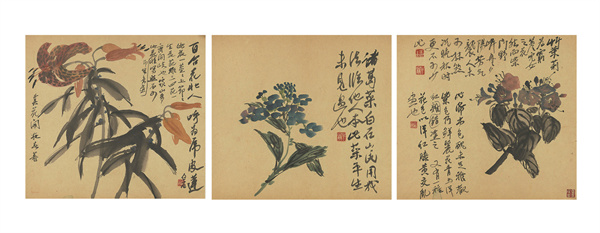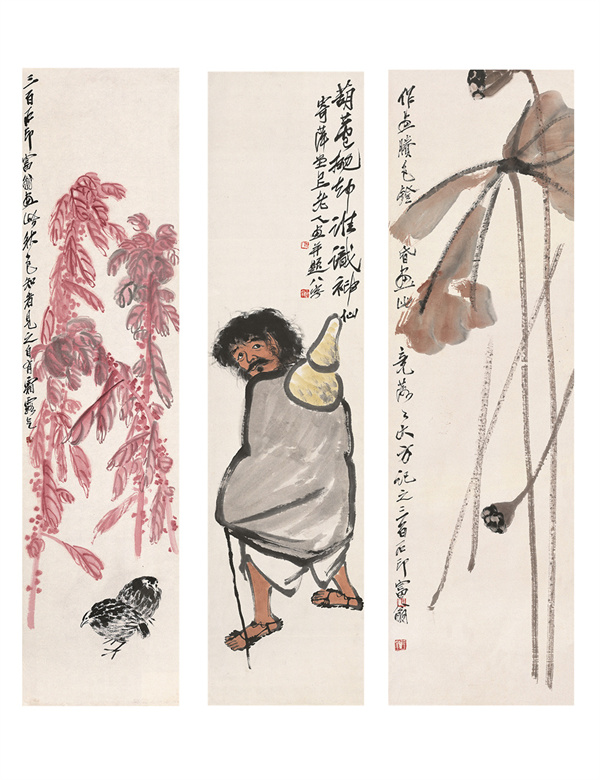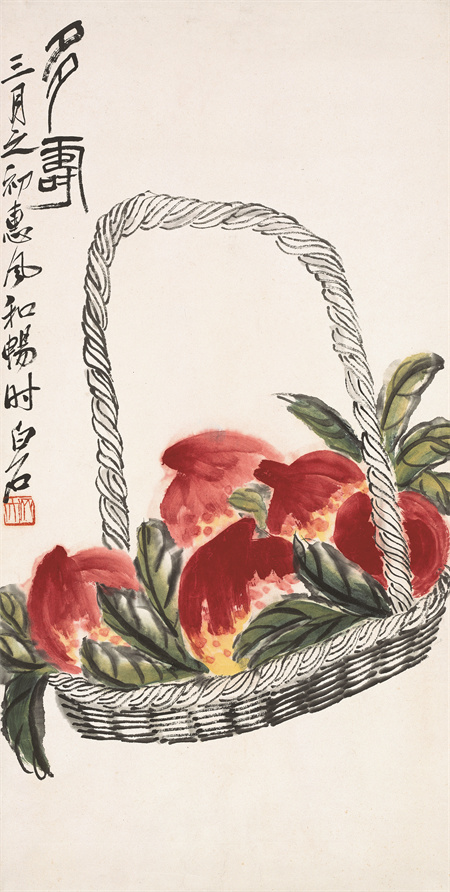Paper trail shows master's technique

Qi Baishi (1864-1957) is revered as one of China's most productive and influential ink artists of the 20th century.[Photo provided to China Daily]
In the great Confucianism text The Analects, Confucius was quoted as saying: "A workman who wants to do his job well must first refine the tools he will use."
For artists of classical Chinese painting, their ideal working companions in their quest for perfection include brushes, ink, paper and ink slabs, all of high quality.
In reality, many painters were used to working on coarse paper, such as Qi Baishi (1864-1957), who came from a humble background and lived frugally even when he became well-known and received commissions from buyers.
Regarded as one of the most productive and influential ink artists of the 20th century, Qi left an oeuvre of not only formal pieces done on fine paper but also drawings and sketches made casually and on paper that was inferior in quality often meant for other purposes.

Qi Baishi's three paintings from an album of flowers are highlights of Rustic Paper, Great Art, an ongoing exhibition at the Art Museum of the Beijing Fine Art Academy to mark the 160th anniversary of the ink artist's birth.[Photo provided to China Daily]
The latter part of Qi's work has been shown less but still, they are brilliant in technique and aesthetics, deserving of appreciation as stand-alone works of art.
Rustic Paper, Great Art, an exhibition running at the Art Museum of the Beijing Fine Art Academy until October, provides a unique perspective of Qi's world of art, says the exhibition's curator, Du Yuxin.
The many works on show are on paper used for packaging, writing practice, or leftover scraps for various purposes, all of which were deficient in their water absorbing capacity and ink diffusion. They were crumbled and above all, improper for public display. They are in juxtaposition with works done on fine paper for comparison and show clues to Qi's thoughts while creating.
"All his life, Qi left a lot of paintings and casual drawings on such paper, which he found easily and was affordable," Du says. "He didn't throw the paper away because they were more accessible and convenient when he was struck by a thought, or when he traveled extensively to get inspiration from nature. It was also to do with his early life experiences."
Hailing from the countryside of Xiangtan, Hunan province, Qi made a living from carpentry and gained expertise at carving out intricate patterns on architectural structures. He was, meanwhile, a self-taught painter, and it was not until his late 20s that he began painting and studying poetry under learned scholars in his hometown.
The first and primary breakthrough in his career was five journeys across the country after he turned 40, where he was enthralled by distinctive landscapes and made friends in cultural circles that expanded his vision of the world and art.
Before he gained initial fame in his 60s, Qi struggled for years first as a rural artisan and later, after he moved to Beijing in 1919, being sidelined by the elites in the art circles. Du says: "He quite understood the painstaking needed to achieve something. He didn't waste things. He valued every piece of paper for use to improve his art skills, as much as he prized any small chance of progress in his career."

Two ink paintings by Qi Baishi: Tricolor Amaranth Flowers and Quails (left) ; Li Tieguai, One of the Eight Immortals (middle) and Lotus (right).[Photo provided to China Daily]
Impulses to create
A man with a keen interest in nature, Qi grew potted flowers and kept small animals, and he observed attentively wherever he went.
He drew on substandard paper to capture the touches and moods that hit him in an instance and sometimes he would add a brief explanation on the paintings.
Once at a friend's home, he was impressed by a bronze incense burner in the shape of a duck. He was so captivated by its vivid look that he grabbed a piece of paper that was used to support a painting while framing the work, drew on it and meanwhile, wrote down how the duck's feet might move while walking. The drawing is on show at the current exhibition.
A portrait of his friend and sponsor Hu Peiheng, also on show, was made on a piece of packaging paper. Qi drew it to test new painting brushes and found it rather satisfying. He hung it on an iron wire to further examine the work and added brief commentary. People attending the exhibition can see clearly the name and address of the studio that the paper came from.

Longevity.[Photo provided to China Daily]
Hu later recalled that the iron wire was on the northern wall of Qi's home, where he would hang every work with bamboo clips, sit opposite it and give it a thorough review. "If he felt satisfied, he would then add titles and comments, and impress seals. Then the work was truly completed."
The highlight at the exhibition is an album of flowers now in the collection of the Chinese National Academy of Arts. Qi drew dozens of flowers he saw at friends' homes while traveling, or the plants he collected back in his native Hunan. He gave the album to his children for them to learn painting.
He commented on the album that "the paper used is poor quality and therefore, the colors do not look good; it is far from graceful in appearance".
Fan Chen, a resident painter of the Beijing Fine Art Academy, says the album exemplifies how Qi turned work on rough paper into pieces of art, as he endeavored to formulate hues, for example, a bold purple by mixing several colors in a delicate way so that they would actually look alluring in years to come.
In a video at the exhibition, Fan demonstrates how Qi created these colors and painted back then.
"He pushed to his limits on the depiction of details, out of years of observing and feeling, and a respect for nature, the same as it was expressed by artists of the Song Dynasty (960-1279)."
Wu Hongliang, director of the Beijing Fine Art Academy, says even on such paper unsuitable for painting, Qi was implementing his beliefs in art to be not ordinary.

A parrot drawn on a piece of packaging paper.[Photo provided to China Daily]
Commemorative event
The exhibition is one of a series of events organized by Wu's academy to mark the 160th anniversary of Qi's birth this year.
The Beijing Fine Art Academy was founded in May 1957, four months before Qi's death. The artist was named the first — and so far the only — honorable director of the academy, and donated his works and collections to it.
Wu says he hopes the exhibition will add new dimensions to people's understanding of Qi and his art. "He was quite interesting. These works are the documents that preserve his true feelings. They capture the moments when he felt inspiration erupting, wrote casually or considered how to paint."
In the past year, the academy toured Qi's works at home and also abroad to Germany, Sweden and other countries in Europe "to show people the touching world of animated lives that Qi created", Wu says, adding that they will tour the United States this year.
"We hope that by promoting the art and research of Qi, we are also able to draw more attention to the special meanings and important values of Chinese painting in the world cultural scene."
Related articles
-
 Landscape artist rests his heart in between mountains and waters
Landscape artist rests his heart in between mountains and watersMore
-
 "Renoir - The Painter and His models" exhibition opens in Budapest
"Renoir - The Painter and His models" exhibition opens in BudapestMore
-
 Ink artist's landscape painting bridging tradition and modernity
Ink artist's landscape painting bridging tradition and modernityMore
-
 Israeli artist holds exhibition in Tel Aviv to mark her love for Shanghai
Israeli artist holds exhibition in Tel Aviv to mark her love for ShanghaiMore
-
 Dehua porcelain int'l exhibition held at UN
Dehua porcelain int'l exhibition held at UNMore
-
 Traditional New Year pictures on display
Traditional New Year pictures on displayMore
